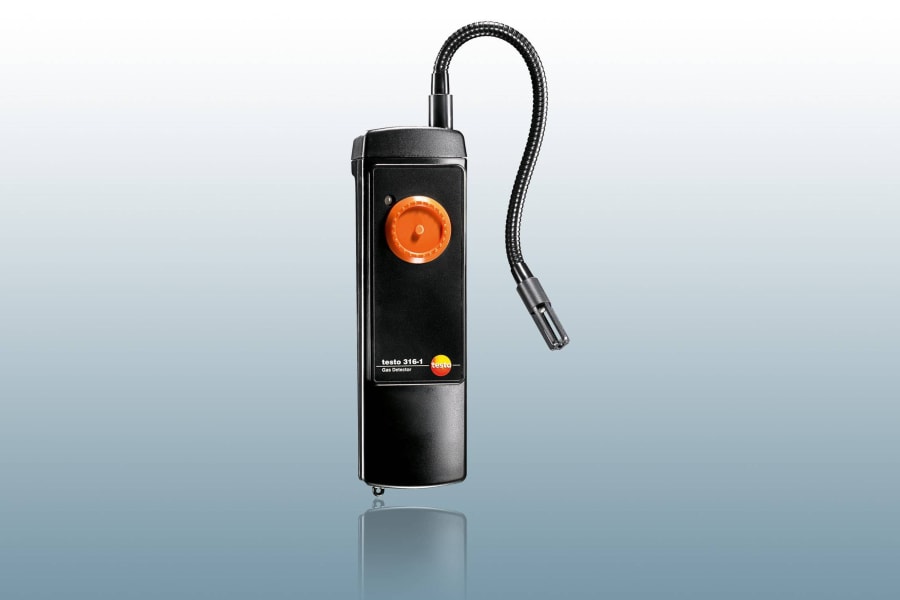Flue gas measuring instruments for industry
Flue gas analysis in industrial installations often needs to be carried out in extreme conditions, involving high temperatures, high humidity or a high dust content in the flue gas, for example. Emission measurements are taken in resource- and energy-intensive processes, during which large quantities of emissions such as carbon monoxide (CO), carbon dioxide (CO2), nitrogen oxides (NOX) or sulphur dioxide (SO2) are produced.

With a number of exhaust gas probes, sensors and special options such as automatic dilution or Peltier gas preparation, the exhaust gas analyzers from Testo were specially developed for extreme demands
A flue gas analyzer from Testo offers you
Numerous measurement parameters: O2, CO, NO, NO2, SO2, CO2, H2S
Extensive selection of probes
Fast access to sensors and wearing parts
Measurement data management via software
Testo emission analyzers for portable, industrial emission measurement
Industrial flue gas analysis
This comprehensive reference guide offers you practical tips and tricks relating to emissions measurements.

The combustion process
Practical knowledge for work in the field
Gas analysis technology
Industrial gas analysis applications
Testo gas analysis technology
And much more ...
Further information about flue gas analysis and emission measurement

Measuring technology for industrial plants
Optimized operation: Maximum efficiency of industrial plants and building technology. Flexible and competent. With Testo.
Learn more
Reference testo 340 Cummins
Reference report from Cummins on the use of the emission measuring instrument testo 340.
Learn more
Reference testo 350 2G Energy
Reference report from 2G Energy on the use of the emission measuring instrument testo 350.
Learn more
Application videos testo 340/350
Reduce emissions. Increase efficiency. The Testo flue gas analyzers.
Learn more
Video instructions: Changing the testo 340 / testo 350 sensor
Handy. Fast. Simple.
Learn more
Video-Trainings: testo 350
Video trainings for Testo's measuring instruments. Learn how to use and operate the Testo measuring instruments in our How-to-Videos.
Learn more
Video-Trainings: testo 340
Video trainings for Testo's measuring instruments. Learn how to use and operate the Testo measuring instruments in our How-to-Videos.
Learn more
Emission analyser applications
Flue gas analyzers for industrial plants: Trust over 60 years’ experience from Testo, and choose the right model for you here.
Learn more
testo easyEmission software
The testo easyEmission PC software offers numerous functions for convenient measurement data management. Request here
Learn moreApplications
When analyzing the burner’s behaviour, the focus of attention is often on fuel supply, atomization, control behaviour and emissions values.
The flue gas analyzers enable all relevant gases to be analyzed and the combustion process to be adjusted so that the best possible ratio of fuel to combustion air quantities is achieved.

Effective flue gas measurement with the testo 300 NEXT LEVEL
Use the testo 300 NEXT LEVEL flue gas analyzer to carry out flue gas measurements easily and efficiently, even on larger systems:
Wireless parallel measurements in record time
Practical second screen function
Easy, intuitive documentation and data integration with your in-house software
Flue gas analysis with Testo: professional and reliable.
Flue gases contain, among others CO2, CO, oxides or soot particles. These pollute the environment, have a negative effect on the climate and conceal numerous health risks for human beings. Flue gas analysis with professional flue gas analyzers from Testo helps to make combustion processes more efficient, to optimize thermal processes, and above all, to reduce emissions.
Protection of the atmosphere thanks to as low a pollutant level as possible
The most efficient use of energy possible
Adherence to prescribed pollutant levels per exhaust gas volume and energy loss




































